
Docker Workshop Session Notes
- Introduction to Containers
- What is Docker? and Containerization?
- Containerization Concept
- Difference(VM vs Containers)
- Advantages and Disadvantages
- Installation
- Docker Architecture
- Docker Workflow
- Docker Commands
- Dockerfile
- Dockerfile Instructions
- Docker Image
- Hands-On Examples(Creating and Containerizing)
- Challanges
- Docker Compose Concept
- Important Docker Commands
- Docker Volumes
1. Introduction
What is Docker?
Docker is a Containerization platform for packaging, deploying, and running applications as CONTAINERS.
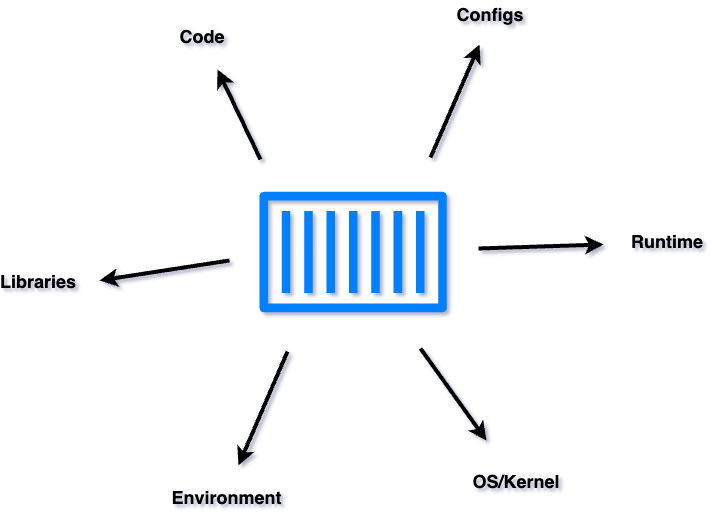
What is containerization? 📦
Containerization is a lightweight form of virtualization that allows you to encapsulate an application and its dependencies into a self-contained unit called a “container.”
Docker applications run in containers that can be used on any system: a developer’s laptop, systems on premises, or in the cloud. (it runs the same)
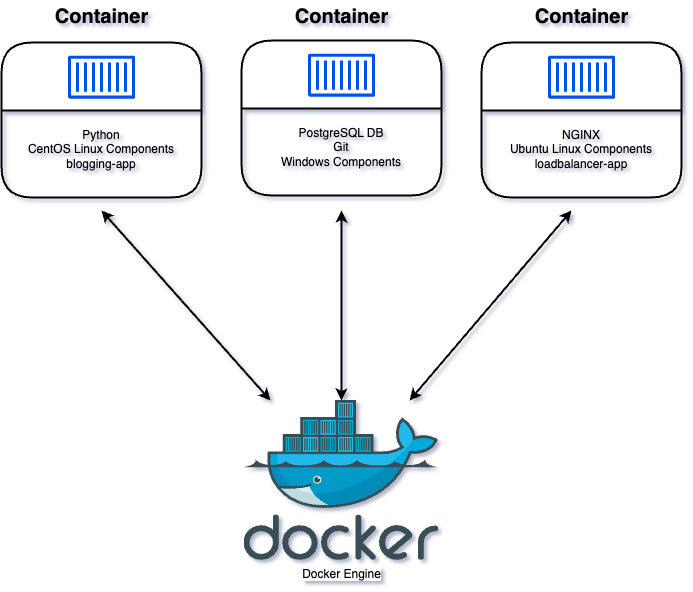
Containers share the host operating system’s kernel, but they have their own isolated file system, processes, and networking.
Difference between VMs & Containers


| Aspect | Containers | Virtual Machines |
|---|---|---|
| OS | Shares host’s Kernel | Has its own Kernel |
| Resource Usage | Lightweight, efficient | Heavier, more resource usage |
| Startup Time | Quick start | Slower start |
| Isolation | Process-level separation | Full OS isolation |
| Portability | Highly portable | Compatibility concerns |
| Resource Overhead | Minimal overhead | Higher overhead |
| Isolation Level | Lighter isolation | Stronger isolation |
Learning Resource:
Containers vs VM - Difference Between Deployment Technologies - AWS
Advantages of Containerization
- Increased Portability
- Easier Scalability
- Easy and Fast Deployments
- Better Productivity
- Improved Security
- Consistent test environment for development and QA.
- Cross-platform packages called images.
- Isolation and encapsulation of application dependencies.
- Ability to scale efficiently, easily, and in real time.
- Enhances efficiency via easy reuse of images.
Disadvantage
- Compatibility issue: Windows container won’t run on Linux machines and vice-versa
Other disadvantages(Discovered by me)😎
- Counter-productivity or efficiency-draining issue: Hard to turn a 5-minute task to a 5-hour task
- Troubleshooting issue: It will be hard, to be able to find tons of dependency issues
2. Installation
3. Docker Architecture
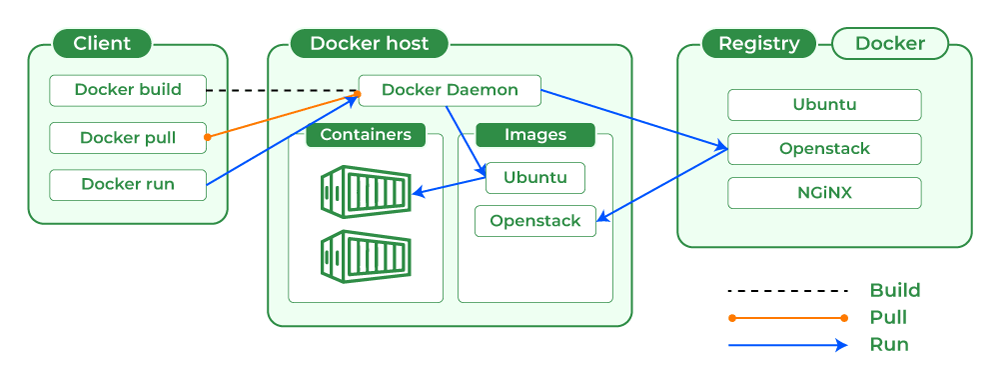
Docker uses a client-server architecture to manage and run containers:
- Docker Client:
- The Docker client is the command-line interface (CLI) or graphical user interface (GUI) that users interact with to build, manage, and control Docker containers.
- It sends commands to the Docker daemon to perform various tasks.
- Docker Daemon:
- The Docker daemon is a background process that manages Docker containers on a host system.
- It listens for Docker API requests and takes care of building, running, and managing containers.
- Docker Registry:
- Docker images can be stored and shared through Docker registries.
- A Docker registry is a repository for Docker images, and it can be public (like Docker Hub) or private.
- Docker Hub:
- Docker Hub is a cloud-based registry service provided by Docker, where users can find, share, and store Docker images.
- It serves as a central repository for Docker images.
Here’s a high-level overview of the interaction between these components:
- The Docker client communicates with the Docker daemon, sending commands and receiving information about containers, images, etc.
- Docker images are fetched or built from the Docker registry.
- Containers are created, started, stopped, and managed by the Docker daemon.
4. Docker Workflow
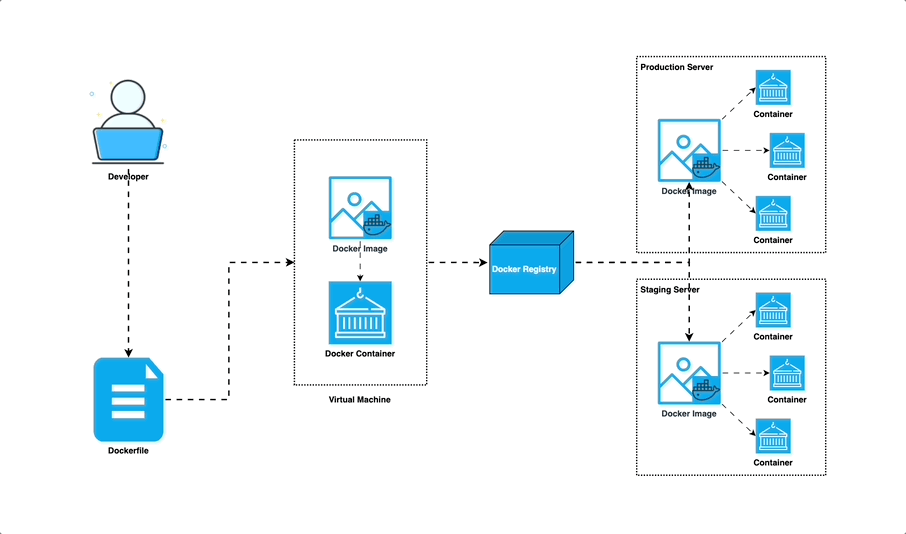
More on Docker? - Ufffffffff!!!!!

5. Docker Commands
- Image Commands:
- docker pull: Pull an image from a registry.
- Example:
docker pull nginx:latest
- Example:
- docker build: Build an image from a Dockerfile.
- Example:
docker build -t myapp:1.0 .
- Example:
- docker images: List all images on the local machine.
- Example:
docker images
- Example:
- docker rmi: Remove an image.
- Example:
docker rmi image_id
- Example:
- docker pull: Pull an image from a registry.
- Container Commands:
- docker run: Run a container from an image.
- Example:
docker run -d -p 8080:80 myapp:1.0
- Example:
- docker ps: List running containers.
- Example:
docker ps
- Example:
- docker stop: Stop a running container.
- Example:
docker stop container_id
- Example:
- docker rm: Remove a stopped container.
- Example:
docker rm container_id
- Example:
- docker exec: Execute a command in a running container.
- Example:
docker exec -it container_id bash
- Example:
- docker logs: View logs of a container.
- Example:
docker logs container_id
- Example:
- docker run: Run a container from an image.
- Volume Commands:
- docker volume ls: List all volumes.
- Example:
docker volume ls
- Example:
- docker volume create: Create a new volume.
- Example:
docker volume create myvolume
- Example:
- docker volume ls: List all volumes.
- Network Commands:
- docker network ls: List all networks.
- Example:
docker network ls
- Example:
- docker network create: Create a new network.
- Example:
docker network create mynetwork
- Example:
- docker network ls: List all networks.
- Docker Compose Commands:
- docker-compose up: Start services defined in a
docker-compose.ymlfile.- Example:
docker-compose up -d
- Example:
- docker-compose down: Stop and remove services defined in a
docker-compose.ymlfile.- Example:
docker-compose down
- Example:
- docker-compose ps: List services and their status.
- Example:
docker-compose ps
- Example:
- docker-compose up: Start services defined in a
- Swarm Commands (for orchestration):
- docker swarm init: Initialize a Docker swarm.
- Example:
docker swarm init
- Example:
- docker service: Manage Docker services in a swarm.
- Example:
docker service ls
- Example:
- docker swarm init: Initialize a Docker swarm.
- System Information:
- docker version: Display Docker version information.
- Example:
docker version
- Example:
- docker info: Display system-wide information about Docker.
- Example:
docker info
- Example:
- docker version: Display Docker version information.
- Image Commands:
- Tag an Image:
- Example:
docker tag myapp:1.0 myregistry/myapp:1.0 - Explanation: Tags an image with a different name, providing a way to reference the same image under different names.
- Example:
- Remove Unused Images:
- Example:
docker image prune - Explanation: Removes all dangling (unused) images.
- Example:
- Remove All Images:
- Example:
docker rmi $(docker images -q) - Explanation: Removes all images on the local machine.
- Example:
- Tag an Image:
- Container Commands:
- Remove Stopped Containers:
- Example:
docker container prune - Explanation: Removes all stopped containers.
- Example:
- Remove All Containers:
- Example:
docker rm -f $(docker ps -aq) - Explanation: Removes all containers, including running ones.
- Example:
- Remove Stopped Containers:
- Volume Commands:
- Remove Unused Volumes:
- Example:
docker volume prune - Explanation: Removes all unused volumes.
- Example:
- Remove Unused Volumes:
- Network Commands:
- Remove Unused Networks:
- Example:
docker network prune - Explanation: Removes all unused networks.
- Example:
- Remove Unused Networks:
- System Cleanup:
- Remove All (Containers, Images, Volumes, Networks):
- Example:
docker system prune -a - Explanation: Removes all stopped containers, unused networks, dangling images, and unused volumes.
- Example:
- Remove All (Containers, Images, Volumes, Networks):
Remember to exercise caution when using commands that remove resources, as they can result in data loss. Always double-check the resources you are about to remove.
6. Dockerfile
Dockerfile Instructions
Docker Image
A Docker image is a read-only template containing a set of instructions for creating a container that can run on the Docker platform. Docker images are also the starting point for anyone using Docker for the first time.
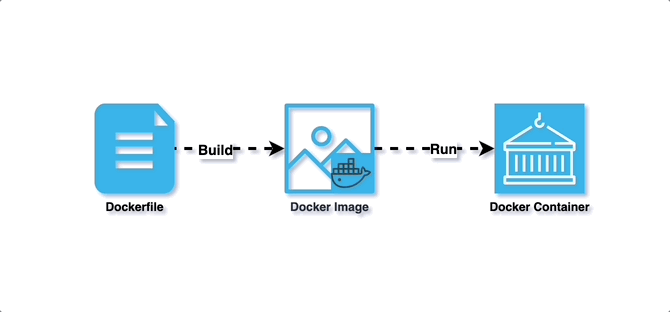
Time for Hands-On? - YEAHHHHH!!!!!

7. Hands-On Practice
Prerequisites:
Make sure following prerequisites are met before you start: - Docker installed on your machine - Docker Compose installed on your machine - Docker Hub account
Task 1
Run a container with the nginx:1.14-alpine image and name it webapp.
Task 2
Containerize Python application and push the image to Dockerhub.
Step 1 - Create Python/NodeJS app. (Clone from GitHub) =>Python OR NodeJS
Step 2 - Write Dockerfile for the app
Step 3 - Create image for the app
Step 4 - Run the container for the app
Step 5 - If it works push the image on Dockerhub (optional)
ENV variables
- Purpose: Environment variables in Docker are used to configure applications, control runtime behavior, and manage sensitive information.
- Configuration: They replace hardcoded values in configuration files, enabling flexibility across different environments.
- Dynamic Behavior: Environment variables can control feature toggles, logging levels, and runtime environments.
- Secrets Management: Sensitive data like passwords or API keys can be securely injected into containers using environment variables.
- Setting Variables:
- Use
ENVinstruction in Dockerfile to set variables during image build. - Pass variables with
-eor--envflag indocker runcommand. - Define them in
docker-compose.ymlunder theenvironmentkey. - In Docker Swarm, set them with
docker service create/updateor in a Docker Compose file for Swarm.
- Use
- Flexibility and Portability: Environment variables make Dockerized applications easier to manage and deploy across multiple environments.
Task 3
Run a container named shrawan-app using image sbmagar/bloggingapp and set the environment variable APP_COLOR to green. Make the application available on port 75666 on the host. The application listens on port 5000.
Commands & Arguments
# Use a base image
FROM alpine:latest
# Run a sleep command when the container starts
CMD ["sleep", "3600"]
CMD ["sleep", "3600"] ✅
CMD ["sleep 3600"] ❌
it’s recommended to use the first form (CMD ["sleep", "3600"]) to specify the command and its arguments as separate elements in a JSON array for clarity and to ensure proper execution.
ENTRYPOINT
ENTRYPOINT is a Dockerfile instruction that specifies the command to run when a container is started from the Docker image. Unlike CMD, which provides default arguments to the command defined by ENTRYPOINT, ENTRYPOINT sets the main command that will be executed when the container starts, regardless of any arguments provided at runtime.
FROM alpine:latest
# Set the sleep command as the entry point
ENTRYPOINT ["sleep"]
# Set a default sleep time of 3600 seconds (1 hour)
CMD ["3600"]
Explanation:
- This Dockerfile starts with a base image of Alpine Linux.
- The
ENTRYPOINTinstruction specifies that thesleepcommand will be the main command to run when the container starts. - The
CMDinstruction sets a default argument for thesleepcommand, specifying the sleep time in seconds. In this case, the default sleep time is 3600 seconds (1 hour).
Override arguments
docker run my_image 1800 # Sleeps for 1800 seconds (30 minutes)
Communication Between containers.
for multiple containers dependent on one another we can command line argument —link
When using the --link option in Docker:
-
A secure tunnel is created between containers for communication.
-
Environment variables are set in the destination container, providing details about the linked container.
-
Docker updates the
/etc/hostsfile in the destination container to resolve the hostname of the linked container. -
Access to exposed ports in the linked container is provided.
-
Docker implicitly creates a network bridge interface for secure communication between linked containers.
-
Example:
-
Run MySQL Container: Start the MySQL container with a name
mysql-container, exposing port 3306:docker run --name mysql-container -e MYSQL_ROOT_PASSWORD=password -d mysql:latest -
Create a .NET Core Application: Assume you have a .NET Core application that needs to connect to the MySQL database. Build the .NET Core application and create a Docker image for it. Here’s a simple Dockerfile assuming the application is published to a folder named
app:FROM mcr.microsoft.com/dotnet/core/runtime:latest WORKDIR /app COPY ./app . ENTRYPOINT ["dotnet", "sampleapp.dll"] -
Run .NET Core Application Container Linked to MySQL: Now, run the .NET Core application container, linking it to the MySQL container:
docker run --name dotnet-app --link mysql-container:mysql -d your-dotnet-image:latest
In this example:
--name mysql-containerassigns the namemysql-containerto the MySQL container.-e MYSQL_ROOT_PASSWORD=passwordsets the root password for MySQL.-name dotnet-appassigns the namedotnet-appto the .NET Core application container.--link mysql-container:mysqllinks the .NET Core application container to the MySQL container with an aliasmysql.-druns both containers in detached mode.
Inside the .NET Core application container, you can now access the MySQL database using the hostname
mysqland the exposed port. Make sure your .NET Core application is configured to connect to MySQL using the correct hostname and port. -
So what then?
8. Docker Compose
A configuration file to run multiple containers in one command
—links
- 1 docker run —name redis redis:alpine ⚠️
- 2 docker run —name redis -d redis:alpine ⚠️
- 3 docker rm redis ⚠️
- 4 docker run —name redis -d redis:alpine ⚠️
- 5 docker run —name luckydrawapp —link redis:redis -p 5000:5000 luckydraw-app:latest ✅✅
- 6 docker rm luckydrawapp ⚠️
- 7 docker run —name luckydrawapp —link redis:redis -d -p 5000:5000 luckydraw-app:latest ✅✅
version: '3.8'
services:
redis:
image: redis:alpine
luckydrawapp:
image: luckydraw-app:latest
ports:
- 5000:5000
9. Docker Volumes
Docker volumes are a way to persist data generated by and used by Docker containers. They provide a mechanism for sharing data between a host machine and Docker containers or between containers themselves.
Types of Volumes:
- Named Volumes: Managed by Docker, easier to use and manage.
- Host Volumes: Maps a directory from the host machine into the container.
- Anonymous Volumes: Similar to named volumes but managed by Docker with a randomly generated name.
Commands:
-
Create a named volume:
docker volume create my_volume -
Run a container with a named volume:
docker run -v my_volume:/path/in/container image_name -
List all volumes:
docker volume ls -
Inspect a volume:
docker volume inspect my_volume -
Remove a volume:
docker volume rm my_volume -
Mount a host directory as a volume:
docker run -v /host/path:/container/path image_name
Dockerfile Example:
# Define a volume
VOLUME /data
# Set working directory
WORKDIR /data
# Copy files into the container
COPY . /data
Docker Compose Example:
version: '3.8'
services:
app:
image: my_app_image
volumes:
- my_volume:/app/data
volumes:
my_volume:
external: true
Lastly, points to remember:
- Volumes are useful for persisting data even if containers are removed.
- They can be shared between containers.
- Docker volumes are stored in a part of the host filesystem which is managed by Docker.
Sourcecode for this site can be found here: https://github.com/sbmagar/sample-app
References: Play With Docker
https://docs.docker.com/guides/
https://docs.docker.com/compose/
https://docs.docker.com/engine/reference/commandline/compose/